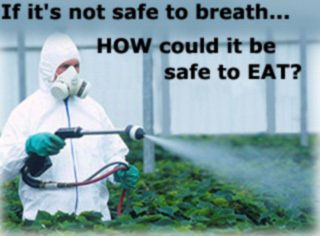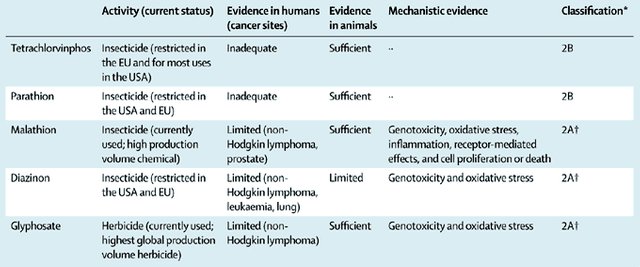Carcinogenicity of tetrachlorvinphos, parathion, malathion, diazinon, and glyphosate

Kathryn Z Guyton, Dana Loomis, Yann Grosse, Fatiha El Ghissassi, Lamia Benbrahim-Tallaa, Neela Guha, Chiara Scoccianti, Heidi Mattock, Kurt Straif, on behalf of the International Agency for Research on Cancer Monograph Working Group, IARC, Lyon, France
Published: 20 March 2015
In March, 2015, 17 experts from 11 countries met at the International Agency for Research on Cancer (IARC; Lyon, France) to assess the carcinogenicity of the organophosphate pesticides tetrachlorvinphos, parathion, malathion, diazinon, and glyphosate (table). These assessments will be published as volume 112 of the IARC Monographs.
Table
IARC classification of some organophosphate pesticides

The insecticides tetrachlorvinphos and parathion were classified as “possibly carcinogenic to humans” (Group 2B). The evidence from human studies was scarce and considered inadequate. Tetrachlorvinphos induced hepatocellular tumours (benign or malignant) in mice, renal tubule tumours (benign or malignant) in male mice, and spleen haemangioma in male rats. Tetrachlorvinphos is a reactive oxon with affinity for esterases. In experimental animals, tetrachlorvinphos is systemically distributed, metabolised, and eliminated in urine. Although bacterial mutagenesis tests were negative, tetrachlorvinphos induced genotoxicity in some assays (chromosomal damage in rats and in vitro) and increased cell proliferation (hyperplasia in rodents). Tetrachlorvinphos is banned in the European Union. In the USA, it continues to be used on animals, including in pet flea collars.For parathion, associations with cancers in several tissues were observed in occupational studies, but the evidence in humans remains sparse. In mice, parathion increased bronchioloalveolar adenoma and/or carcinoma in males, and lymphoma in females. In rats, parathion induced adrenal cortical adenoma or carcinoma (combined), malignant pancreatic tumours, and thyroid follicular cell adenoma in males, and mammary gland adenocarcinoma (after subcutaneous injection in females).Parathion is rapidly absorbed and distributed. Parathion metabolism to the bioactive metabolite, paraoxon, is similar across species. Although bacterial mutagenesis tests were negative, parathion induced DNA and chromosomal damage in human cells in vitro. Parathion markedly increased rat mammary gland terminal end bud density. Parathion use has been severely restricted since the 1980s.The insecticides malathion and diazinon were classified as “probably carcinogenic to humans” (Group 2A). Malathion is used in agriculture, public health, and residential insect control. It continues to be produced in substantial volumes throughout the world. There is limited evidence in humans for the carcinogenicity of malathion. Case-control analyses of occupational exposures reported positive associations with non-Hodgkin lymphoma in the USA, Canada, and Sweden, although no increased risk of non-Hodgkin lymphoma was observed in the large Agricultural Health Study cohort (AHS). Occupational use was associated with an increased risk of prostate cancer in a Canadian case-control study and in the AHS, which reported a significant trend for aggressive cancers after adjustment for other pesticides. In mice, malathion increased hepatocellular adenoma or carcinoma (combined). In rats, it increased thyroid carcinoma in males, hepatocellular adenoma or carcinoma (combined) in females, and mammary gland adenocarcinoma after subcutaneous injection in females. Malathion is rapidly absorbed and distributed. Metabolism to the bioactive metabolite, malaoxon, is similar across species. Malaoxon strongly inhibits esterases; atropine reduced carcinogenesis-related effects in one study. Malathion induced DNA and chromosomal damage in humans, corroborated by studies in animals and in vitro. Bacterial mutagenesis tests were negative. Compelling evidence supported disruption of hormone pathways. Hormonal effects probably mediate rodent thyroid and mammary gland proliferation.Diazinon has been applied in agriculture and for control of home and garden insects. There was limited evidence for diazinon carcinogenicity in humans. Positive associations for non-Hodgkin lymphoma, with indications of exposure–response trends, were reported by two large multicentre case-control studies of occupational exposures., The AHS reported positive associations with specific subtypes, which persisted after adjustment for other pesticides, but no overall increased risk of non-Hodgkin lymphoma. Support for an increased risk of leukaemia in the AHS was strengthened by a monotonic increase in risk with cumulative diazinon exposure after adjustment for other pesticides. Multiple updates from the AHS consistently showed an increased risk of lung cancer with an exposure–response association that was not explained by confounding by other pesticides, smoking, or other established lung cancer risk factors. Nonetheless, this finding was not replicated in other populations. In rodents, diazinon increased hepatocellular carcinoma in mice and leukaemia or lymphoma (combined) in rats, but only in males receiving the low dose in each study. Diazinon induced DNA or chromosomal damage in rodents and in human and mammalian cells in vitro. Some additional support for human relevance was provided by a positive study of a small number of volunteers exposed to a diazinon formulation.

Glyphosate is a broad-spectrum herbicide, currently with the highest production volumes of all herbicides. It is used in more than 750 different products for agriculture, forestry, urban, and home applications. Its use has increased sharply with the development of genetically modified glyphosate-resistant crop varieties. Glyphosate has been detected in air during spraying, in water, and in food. There was limited evidence in humans for the carcinogenicity of glyphosate. Case-control studies of occupational exposure in the USA, Canada, and Sweden reported increased risks for non-Hodgkin lymphoma that persisted after adjustment for other pesticides. The AHS cohort did not show a significantly increased risk of non-Hodgkin lymphoma. In male CD-1 mice, glyphosate induced a positive trend in the incidence of a rare tumour, renal tubule carcinoma. A second study reported a positive trend for haemangiosarcoma in male mice. Glyphosate increased pancreatic islet-cell adenoma in male rats in two studies. A glyphosate formulation promoted skin tumours in an initiation-promotion study in mice.Glyphosate has been detected in the blood and urine of agricultural workers, indicating absorption. Soil microbes degrade glyphosate to aminomethylphosphoric acid (AMPA). Blood AMPA detection after poisonings suggests intestinal microbial metabolism in humans. Glyphosate and glyphosate formulations induced DNA and chromosomal damage in mammals, and in human and animal cells in vitro. One study reported increases in blood markers of chromosomal damage (micronuclei) in residents of several communities after spraying of glyphosate formulations. Bacterial mutagenesis tests were negative. Glyphosate, glyphosate formulations, and AMPA induced oxidative stress in rodents and in vitro. The Working Group classified glyphosate as “probably carcinogenic to humans” (Group 2A).
(Source: THE LANCET AND HUGO KUSMUS).
(LINK: http://www.thelancet.com/journals/lanonc/article/PIIS1470-2045(15)70134-8/fulltext)
If the information you like, please give your vote and share it with your friends.
I thank you very much.
IF YOU WANT TO KNOW MORE, THIS IS MY BLOG.
My recent post:
- WE LIVE IN A PERVERSE SYSTEM
- Poison on our table?
- Hola Steemit! - Hello Steemit!
- Inspiración - Inspiration
- Inspiración Semillas - Inspiration Seeds